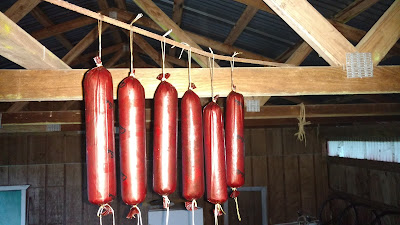Thanksgiving weekend was a fun four day break from the day job, but work on the farm is really a seven days a week kind of gig. We did take most of Thanksgiving day to enjoy making a nice turkey dinner and visiting with family. Theresa also spent a couple of days helping fund-raise during Zach's four Nutcracker performances on Saturday and Sunday, selling raffle tickets, so basically we were all busy doing something. I spent much of the weekend grading the driveway with the box scraper implement behind the tractor and laying down fresh gravel by shovel from the back of the farm truck. It will be a big improvement to help keep the mud from getting tracked into the house. I'll share all those "improvement" details in another post though, with pictures. This is supposed to be about the turkey.
For the second year we deep fried our turkey, and it was a success. Unfortunately we didn't get any pictures of the operation, before or after. I guess we were all busy doing stuff and forgot the most import part of capturing those memories in a photo op. Anyway, we decided to deep fry again because last year's turkey was really tasty. I guess for years we were using our big roaster to slow cook our 'big birb', but it really seemed like a lot of cooking time which kept the kitchen tied up. A couple of years ago I tried something different and cut the turkey into pieces before roasting to cut down on the cook time, and it turned out pretty good. We've noticed how deep frying has become more popular, and apparently starting fires trying to deep fry has also become a thing since there are so many PSAs about how to safely deep fry. Last year we decided to risk starting our own fire and took on the dangerous cooking method of deep frying, and it turned out a good choice. It was easily the tastiest 'birb' we've cooked and really not as scary or dangerous as the PSAs make it out to be. We just used some common sense and care in operating the deep fryer.
It's amazing how quickly a 20 lb turkey will cook in a deep fryer. I guess the only real disadvantage is that you don't get to stuff your turkey, but that wasn't a huge issue for us since stuffing has never been that popular in our house. I love stuffing, but it can always be made on the side. This year Theresa injected the bird with melted butter and seasonings before I lowered it into the boiling peanut oil. It came out an hour later cooked to perfection, juicy delicious. We paired our bird with a selection of sides, like: my traditional twice baked potatoes; our new comer India's spinach bake; Zach's famous mac-n-cheese; Tsa's green bean casserole; candied yams; and 300 bottles of Martenellis. The only real cooking fail this year was my twice bakes were ruined when I forgot to add bacon!
Overall dinner turned out really well and it was a nice Thanksgiving. The only thing I would have liked more was to see more of the family and maybe a few more pics, next year with any luck though. I hope all of you enjoyed your Thanksgiving weekend!
 |
| First Thanksgiving Dinner on the Farm |





















